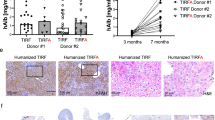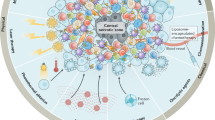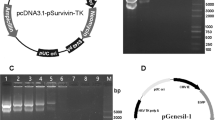Abstract
Targeting of colorectal liver metastases by regional gene therapy was tested in a clinically relevant syngeneic model. First, the CEA-CD-113 retroviral vector containing the cytosine deaminase gene controlled by the CEA specific tumour cell promoter, was shown in vitro to convert 5-fluorocytosine to 5-fluorouracil, resulting in cancer cell killing with a large bystander effect. Second, 10 days after the establishment of liver metastases, retroviral vectors were delivered to the liver by hepatic artery injection. After 5-fluorocytosine administration for 7 days, most surface metastases disappeared and tumour volumes were suppressed up to 8.2-fold. The results support the development of this approach for patient treatment.
This is a preview of subscription content, access via your institution
Access options
Subscribe to this journal
Receive 12 print issues and online access
$259.00 per year
only $21.58 per issue
Buy this article
- Purchase on Springer Link
- Instant access to full article PDF
Prices may be subject to local taxes which are calculated during checkout




Similar content being viewed by others
References
Parker SL, Tong T, Bolden S, Wingo PA . Cancer statistics, 1996 CA Cancer J Clin 1996 46: 5–27
Geoghegan JG, Scheele J . Treatment of colorectal liver metastases Br J Surg 1999 86: 158–169
Jarnagin WR et al. Liver resection for metastatic colorectal cancer: assessing the risk of occult irresectable disease J Am Coll Surg 1999 188: 33–42
Rougier P et al. Prospective study of prognostic factors in patients with unresected hepatic metastases from colorectal cancer Br J Surg 1995 82: 1397–1400
Simmonds PC . Palliative chemotherapy for advanced colorectal cancer: systematic review and meta-analysis. Colorectal Cancer Collaborative Group Br Med J 2000 321: 531–535
Jonker DJ, Maroun JA, Kocha W . Survival benefit of chemotherapy in metastatic colorectal cancer: a meta-analysis of randomized controlled trials Br J Cancer 2000 82: 1789–1794
Breedis C, Young G . The blood supply of neoplasms in the liver Am J Pathol 1954 30: 969–985
Ackerman NB . The blood supply of experimental liver metastases. IV. Changes in vascularity with increasing tumor growth Surgery 1974 75: 589–596
Kemeny N et al. Intrahepatic or systemic infusion of fluorodeoxyuridine in patients with liver metastases from colorectal carcinoma. A randomised trial Ann Intern Med 1987 107: 459–465
Rougier P et al. Hepatic arterial infusion of floxuridine in patients with liver metastases from colorectal carcinoma: long-term results of a prospective randomised trial J Clin Oncol 1992 10: 1112–1118
Allen-Mersh TG et al. Quality of life and survival with continuous hepatic-artery floxuridine infusion for colorectal liver metastases Lancet 1994 344: 1255–1260
Meta-Analysis Group in Cancer . Reappraisal of hepatic arterial infusion in the treatment of nonresectable liver metastases from colorectal cancer J Natl Cancer Inst 1996 88: 252–258
Harmantas A, Rotstein LE, Langer B . Regional versus systemic chemotherapy in the treatment of colorectal carcinoma metastatic to the liver. Is there a survival difference? Meta-analysis of the published literature Cancer 1996 78: 1639–1645
Lorenz M, Muller HH . Randomized, multicenter trial of fluorouracil plus leucovorin administered either via hepatic arterial or intravenous infusion versus fluorodeoxyuridine administered via hepatic arterial infusion in patients with nonresectable liver metastases from colorectal carcinoma J Clin Oncol 2000 18: 243–254
O'Connell MJ et al. Sequential intrahepatic fluorodeoxyuridine and systemic fluorouracil plus leucovorin for the treatment of metastatic colorectal cancer confined to the liver J Clin Oncol 1998 16: 2528–2533
Kemeny N et al. Arterial infusion of chemotherapy after resection of hepatic metastases from colorectal cancer N Engl J Med 1999 341: 2039–2048
Chen S-H et al. Combination suicide and cytokine gene therapy for hepatic metastases of colon carcinoma: sustained antitumor immunity prolongs animal survival Cancer Res 1996 56: 3758–3762
Ohwada A, Hirshowitz EA, Crystal RG . Regional delivery of adenovirus vector containing the Escherichia coli cytosine deaminase gene to provide local activation of 5-fluorocytosine to suppress the growth of colon carcinoma metastatic to liver Hum Gene Ther 1996 7: 1567–1576
Austin EA, Huber BE . A first step in the development of gene therapy for colorectal carcinoma: cloning, sequencing and expression of E. coli cytosine deaminase Mol Pharmacol 1993 43: 380–387
Mullen CA, Kilstrup M, Blaese RM . Transfer of the bacterial gene for cytosine deaminase to mammalian cells confers lethal sensitivity to 5-fluorocytosine: a negative selection system Proc Natl Acad Sci USA 1992 89: 33–37
Huber BE et al. In vivo antitumor activity of 5-fluorocytosine on human colorectal carcinoma cells genetically modified to express cytosine deaminase Cancer Res 1993 53: 4619–4626
Huber BE et al. Metabolism of 5-fluorocytosine to 5-fluorouracil in human colorectal tumor cells transduced with cytosine deaminase gene: significant antitumor effects when only a small percentage of tumor cells express cytosine deaminase Proc Natl Acad Sci USA 1994 91: 8302–8306
Mullen CA, Coale MM, Lowe R, Blaese RM . Tumors expressing the cytosine deaminase gene can be eliminated in vivo with 5FC and induce protective immunity to wild type tumor Cancer Res 1994 54: 1503–1506
Trinh QT et al. Enzyme/prodrug gene therapy: comparison of cytosine deaminase/5-fluorocytosine versus thymidine kinase/ganciclovir enzyme/prodrug system in human colorectal carcinoma cell line Cancer Res 1995 7: 2235–2245
Richards CA, Austin EA, Huber BE . Transcriptional regulatory sequence of carcinoembryonic antigen: identification and use with cytosine deaminase for tumor-specific gene therapy Hum Gene Ther 1995 6: 881–893
Hirschowitz EA et al. In vivo adenovirus-mediated gene transfer of the Escherichia coli cytosine deaminase gene to human colon carcinoma-derived tumors induces chemosensitivity to 5-fluorocytosine Hum Gene Ther 1995 6: 1055–1063
van der Eb MM et al. Severe hepatic dysfunction after adenovirus-mediated transfer of the herpes simplex virus thymidine kinase gene and ganciclovir administration Gene Therapy 1998 5: 451–458
Lawrence TS et al. Preferential cytotoxicity of cells transduced with cytosine deaminase compared to bystander cells after treatment with 5-fluorocytosine Cancer Res 1998 58: 2588–2593
Qian C et al. Gene transfer and therapy with adenoviral vector in rats with diethylnitrosamine-induced hepatocellular carcinoma Hum Gene Ther 1997 8: 349–358
Brand K et al. Liver associated toxicity of the HSV-TK/GCV approach and adenoviral vectors Cancer Gene Ther 1997 4: 9–16
Lan K-H et al. In vivo selective gene expression and therapy mediated by adenoviral vectors for human carcinoembryonic antigen-producing gastric carcinoma Cancer Res 1997 57: 4279–4284
Green NK et al. Sensitization of colorectal and pancreatic cancer lines to the prodrug 5-(aziridin-1-yl)-2,4-dinitrobenzamide (CB1954) by retroviral transduction and expression of the E. coli nitroreductase gene Cancer Gene Ther 1997 4: 229–238
Caruso M et al. Regression of established macroscopic liver metastases after in situ transduction of a suicide gene Proc Natl Acad Sci USA 1993 90: 7024–7028
Freeman SM et al. The ‘bystander effect’: tumour regression when a fraction of the tumor mass is genetically modified Cancer Res 1993 53: 5274–5283
Mar E-C, Chiou J-F, Cheng Y-C, Huang E-S . Inhibition of cellular DNA polymerase α and human cytomegalovirus-induced DNA polymerase by the triphosphates of 9-(2-hydroxyethoxymethyl)guanine and 9-(1,3-dihydroxy-2-propoxymethyl)guanine J Virol 1985 53: 776–780
Samejima Y, Meruelo D . ‘Bystander killing’ induces apoptosis and is inhibited by forskolin Gene Therapy 1995 2: 50–58
Pitts JD . Cancer gene therapy: a bystander effect using the gap junctional pathway Mol Carcinog 1994 11: 127–139
Block A et al. Gene therapy of metastatic colon carcinoma: regression of multiple hepatic metastases by adenoviral expression of bacterial cytosine deaminase Cancer Gene Ther 2000 7: 438–445
Yang Y, Wilson JM . Clearance of adenovirus-infected hepatocytes by MHC class I-restricted CD4(+) CTLs in vivo J Immunol 1995 155: 2564–2570
Miller DG, Adam MA, Miller AD . Gene transfer by retrovirus vectors occurs only in cells that are actively replicating at the time of infection Mol Cell Biol 1990 10: 4239–4242
Kievit E et al. Superiority of yeast over bacterial cytosine deaminase for enzyme/prodrug gene therapy in colon cancer xenografts Cancer Res 1999 59: 1417–1421
Bradford MM . A rapid and sensitive method for the quantification of microgram quantities of protein utilizing the principle of protein-dye binding Anal Biochem 1976 72: 248–254
Acknowledgements
We are grateful to John Yates and Gerry Lepts (University of Liverpool) for technical support.
Author information
Authors and Affiliations
Rights and permissions
About this article
Cite this article
Humphreys, M., Ghaneh, P., Greenhalf, W. et al. Hepatic intra-arterial delivery of a retroviral vector expressing the cytosine deaminase gene, controlled by the CEA promoter and intraperitoneal treatment with 5-fluorocytosine suppresses growth of colorectal liver metastases. Gene Ther 8, 1241–1247 (2001). https://doi.org/10.1038/sj.gt.3301518
Received:
Accepted:
Published:
Issue Date:
DOI: https://doi.org/10.1038/sj.gt.3301518
Keywords
This article is cited by
-
New therapies for hepatocellular carcinoma
Oncogene (2006)



